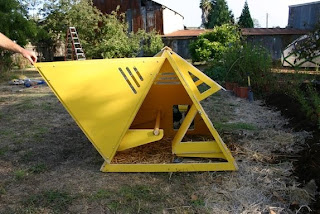I'm about done with the first part of the long-awaited (by me) inventory of modern houses in Pound Ridge, and what I've documented is something that we've suspected for a while: Pound Ridge has a remarkable concentration of modern houses. Our town of just 4,800 people has at least 57 modern houses (New Canaan, with 20,000 people, has 91).
My methodology was this: I drove around town and looked at all the houses; if I thought it fit my notion of "modern," I put it on the list; then at work, where we subscribe to a data base with all property records from Westchester County, I took a few minutes at the end of the day and looked up the owners, the date the houses were built and renovated, the square footage, and when it was last sold.

I have no real definition of "modern," except that I know it when I see it (I realize I'll need to refine this a bit). Big contemporary houses didn't make the list (although houses by Vuko Tashkovich probably deserve their own category). Most of the houses are from the 1950s, but I don't consider date of construction to be definitive -- one of the houses on my list was finished earlier this year. Many if not most are exceedingly modest and I like them because they hearken back to the idea, prevalent after World War II, that modern houses would be democratic houses, places for regular people to live rationally and cheaply, rather than showplaces. The road with the most modern houses happens to be Eastwoods Road, where Gina grew up -- there are 13 that I know of (11 visible from the road and two down long driveways), including houses by Edward Larabee Barnes,
Leroy Binkley and
Bimel Kehm, and there may be others hidden in the woods.
There are a number of houses on my list that I need to show Gina, to see if she concurs with my judgment that they're indeed modern. One in particular is giving me trouble: a big rectangular brick house with a flat roof and casement windows that was built in 1937. It's not a Colonial, not a salt box, not a ranch. If Gina and I agree that it's a pre-War modern, it means that our pre-War modern, built in 1939, is not the first modern house in Pound Ridge, a claim we have been making for years.
I'm not sure what I'm going to do with the list. In a number of places --
New Canaan, for example, and the Vilage Creek neighborhood of Norwalk -- people are working to create districts that qualify for the National Register of Historic Places. I can't imagine having the time to put together a National Register application and I have no clue whether Pound Ridge's houses would even qualify. Except for the three architects I mentioned above, and the archtects of our house and our next door neighbors (Moore & Htchins), I have virtually no information about architects who worked in Pound Ridge. Tracking down that information would be a project in itself.
What happens now? What we really need is someone with actual architectural expertise to identify and compile details like
those used in New Canaan's inventory. But our list is a good start. -- ta






























